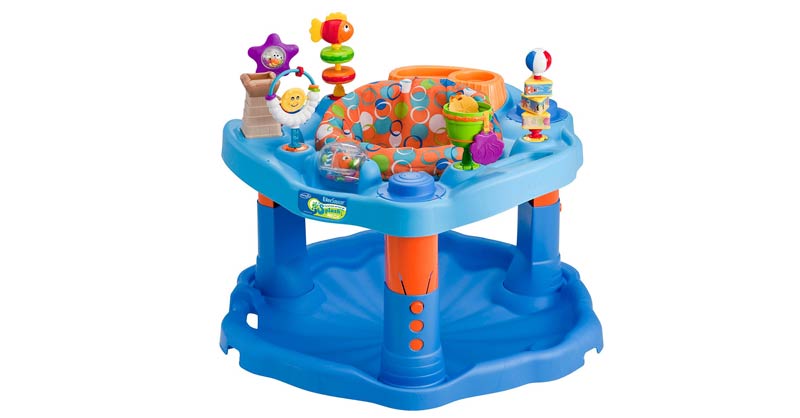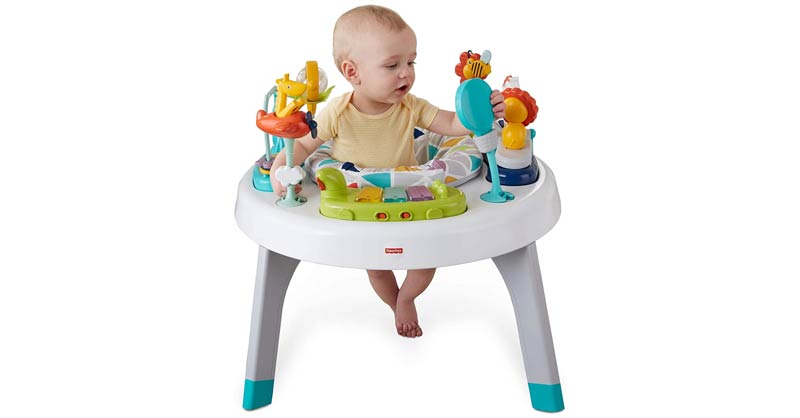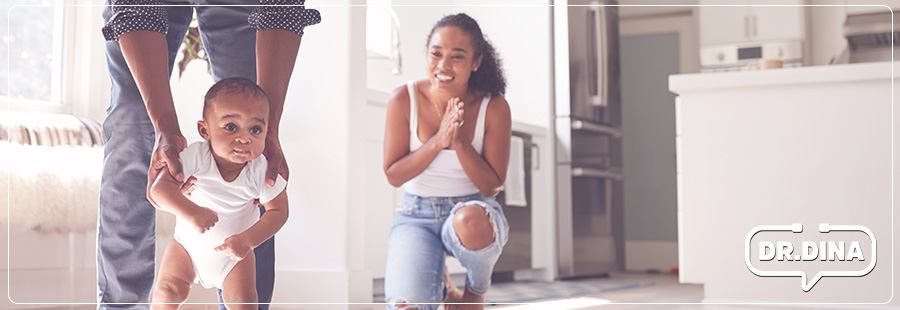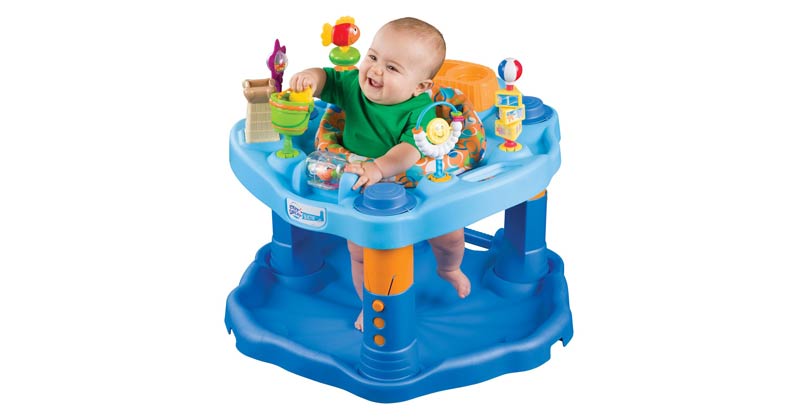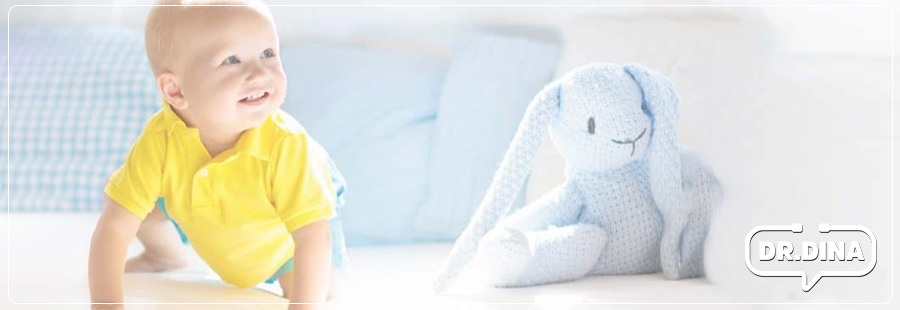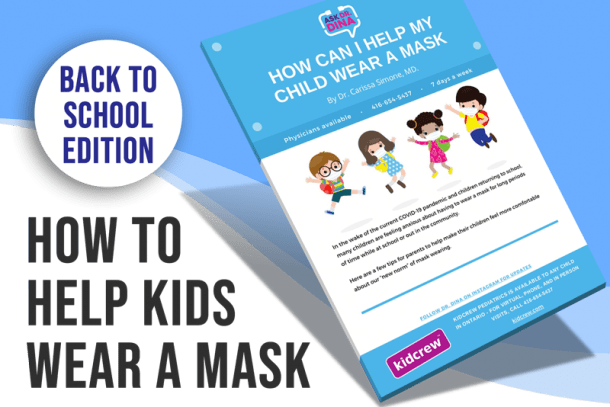Let’s talk about why you should limit your baby’s ExerSaucer playtime!
Are ExerSaucers Safe?
As moms and dads, we all know the precious time we can get to ourselves is minimal. Having five minutes to grab laundry or have a cup of coffee is hard to come by. That’s why we are elated when we find something like the ExerSaucer that will contain our babies and keep them happy.
ExerSaucers are more manageable than baby walkers and easier on your back than baby carriers. Unfortunately, ExerSaucer playtime has its downsides. In particular, physical and occupational therapists oppose the ExerSaucer.
A question I often get asked is, ‘Are ExerSaucers bad for babies?’
As a mom and pediatrician, I think it is best to take a balanced approach to this topic. In your parenting journey, it’s essential to understand what these devices are doing well and not so well so that the perks can be enjoyed without hindering an infant’s development:
Poor Posture and Positioning
When seated in the ExerSaucer, an infant’s legs are typically externally rotated and slightly extended if they are leaning forward. While infants enjoy this position as it enables them to move around freely, it is not a movement pattern conducive to learning to walk.
They also place babies in a position whereby the babies have to lock their knees when standing to compensate for weakness since they are not developmentally ready to stand.
Often babies will stand on their toes when placed in the ExerSaucer. This can lead to overdevelopment of calf muscles and, in severe cases, lead to toe walking.
Decreased Balance
There is concern that when infants spend a lot of time in an ExerSaucer or jumper, they end up seated in a position where their center of gravity remains forward, compromising their development of balance and movement patterns.
Christie Killey from MamaOT describes these concerns:
“Our bodies develop a sense of balance through the feedback given to us by receptors in our muscles and joints (called proprioceptors). When we lose our balance, these receptors send a message to our brain (which goes back to our body), telling us to adjust our position to avoid falling. This message is non-existent when placed in an ExerSaucer. Many babies also have difficulty developing a sense of balance control while in ExerSaucers because they can’t see their feet, which is something they need to be able to do when learning how to stand and balance independently.”
Lack of Exploration
The final concern is, unfortunately, one of the reasons the ExerSaucer is most appealing to parents: it limits an infant’s need and ability to explore their environment as it keeps them in one place.
It’s crucial to encourage rolling, scooting, pulling to stand, cruising, and reaching. We want to challenge these skills and progress them as they master each one.
Playing on a floor allows these skills to be explored in positions such as their tummy, back, seated, hands and knees, and standing. An ExerSaucer simply doesn’t allow for this freedom of movement.
The ExerSaucer Isn’t All Bad
ExerSaucer playtime allows children to be safely self-contained and spend time in a device that provides stimulation and promotes infant motor development . Not to mention, it also provides caregivers with a much-needed break.
Because of the concerns noted above, it is recommended that parents limit time in these devices to 15-20 minutes per day, enough time to start a load of laundry or grab a cup of coffee and a few minutes peace, without guilt.
That being said, there are some things you can do to make sure the time your baby spends in the ExerSaucer is the safest it can be.
- Wait until your baby can sit independently before placing them in the ExerSaucer. This is usually around 6 or 7 months. This prevents them from assuming a poor posture when using the ExerSaucer, as they will have developed the needed trunk and core strength to support that position.
- If you have a younger baby that wants to engage with the ExerSaucer, then either allow them to sit at the outside edge of the ExerSaucer, with your support, or remove the toys and allow your baby to play with them on the floor.
- Pay attention to the age and weight limits of the ExerSaucer. Just as a child shouldn’t be placed in it when they are too young, they can grow out of it too. When your baby is either two years old or above 25lbs, whichever comes first, it’s time to give up the ExerSaucer.
ExerSaucer Time Should Be Limited
All in all, ExerSaucers can be great for developing hand-eye coordination and promoting sensory and motor skills if you keep it to a minimum and keep up your interactions with your baby while they’re enjoying their short burst of ExerSaucer time.
It is considered a far safer alternative to baby walkers, and therefore if you’re looking for something to allow you five minutes of peace while you do a chore, the ExerSaucer is a good tool for that. Continue listening to health experts, and keep up the excellent work!
Frequently Asked Questions
There are some questions you hear time and time again regarding ExerSaucers. Here are a few of the most frequently asked ones.
1. Are ExerSaucers Bad for Babies?
As with most things, there’s a time and a place for it. ExerSaucers and baby jumpers are lifesavers when you need a quick five minutes to do something.
This allows us as caregivers to get what we need done without compromising our children’s development, which is an absolute god-send to most parents. However, if they are used excessively or incorrectly, they can be damaging to our babies’ progress.
2. Should a Baby’s Feet Touch the Bottom of The ExerSaucer?
It is advised that only the baby’s toes touch the floor. They shouldn’t be able to stand flat-footed.
A great tip is placing a pillow beneath their feet; that way, they are not entirely on their tip-toes or flat-footed, as both of these are considered ‘abnormal’ positions.
This means that these positions are not something your baby would assume without the ExerSaucer.
3. How Long Is an ExerSaucer Good For?
ExerSaucers are absolutely fine for short periods: around fifteen minutes per day. There’s nothing wrong with placing your baby in there while you have a quick five-minute coffee break or put a load of washing in.
Any longer than fifteen minutes are when you might start to see a developmental impact. It’s always better to err on the side of caution.
4. When Should a Baby Stop Using a Jumper?
The ExerSaucer comes with guidelines regarding when you should be putting it to one side for good.
When your baby is either two years old or above 25lbs, your baby is considered to be too developed and probably too big to use the ExerSaucer.
Remember, also, to give your baby plenty of on-the-floor playing time or with an exercise ball, as this is the best way to encourage and support your baby’s gross motor development.
5. What Is the Professional Medical Advice Around ExerSaucers?
If you notice your baby is struggling with the ExerSaucer, do not attempt self treatment based remedies. For medical emergencies, you’re better off contacting a professional. This article is for educational purposes and is meant to guide your decisions with your baby.
Try not to disregard professional medical advice: If you have more questions or safety concerns about an ExerSaucer for your baby, consulting with a qualified healthcare provider is the best way to avoid a medical emergency and stunted development in the future.

Lauren is a registered occupational therapist working in Toronto. She has worked and trained in a variety of community, school and hospital settings, She has an interest in working with children and adults on motor development, co-ordination, fine and gross motor skills and adaptations for play, self-care and productivity.

